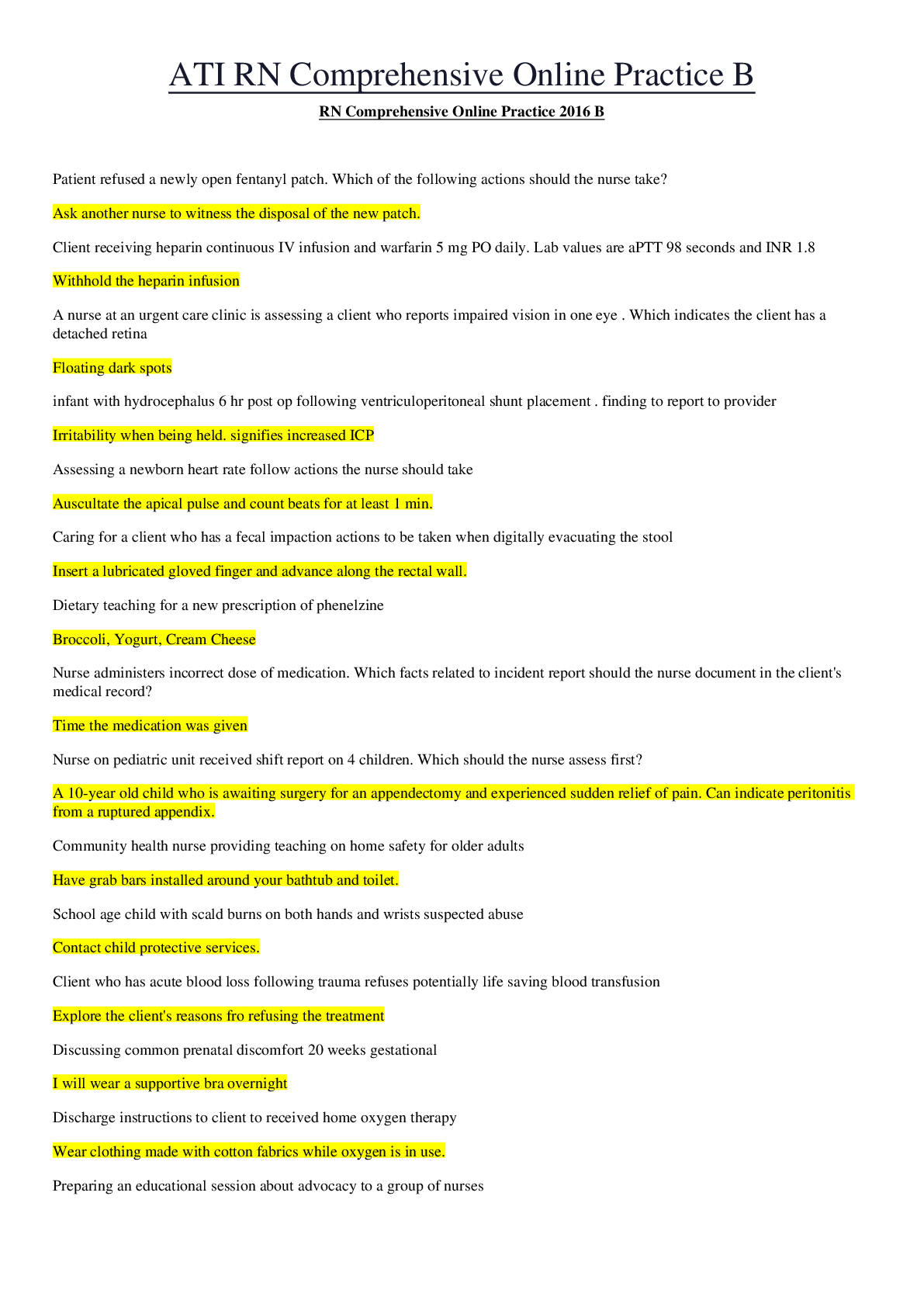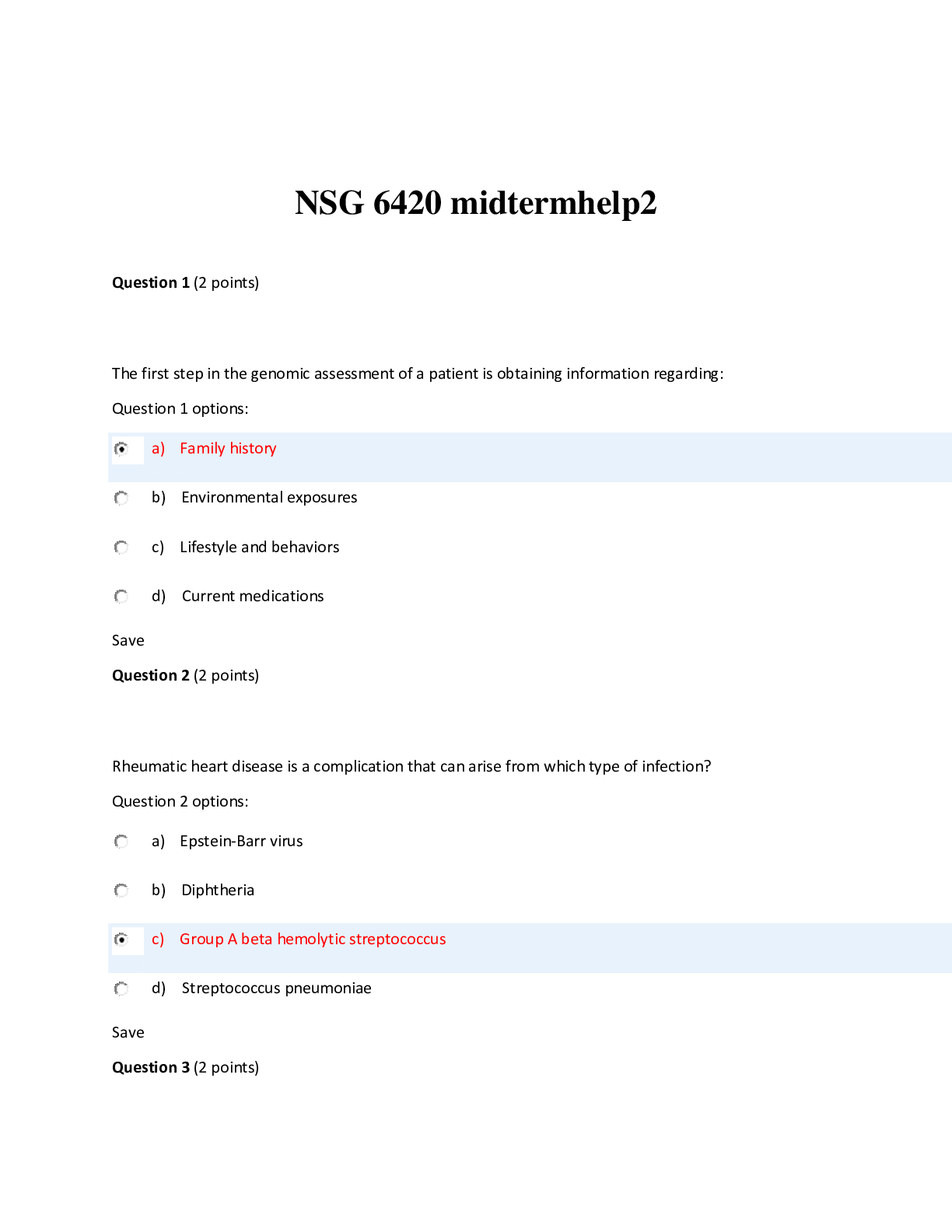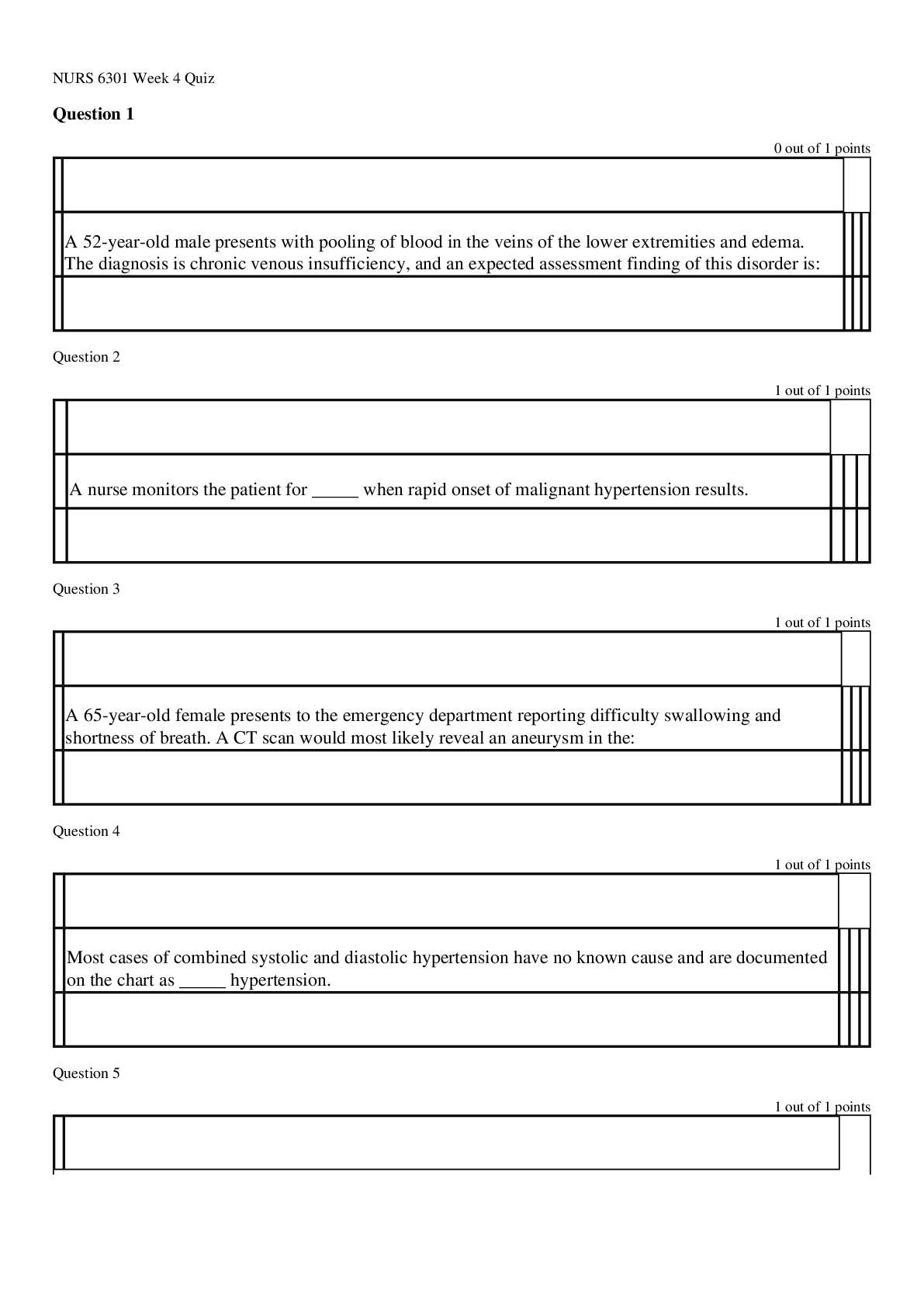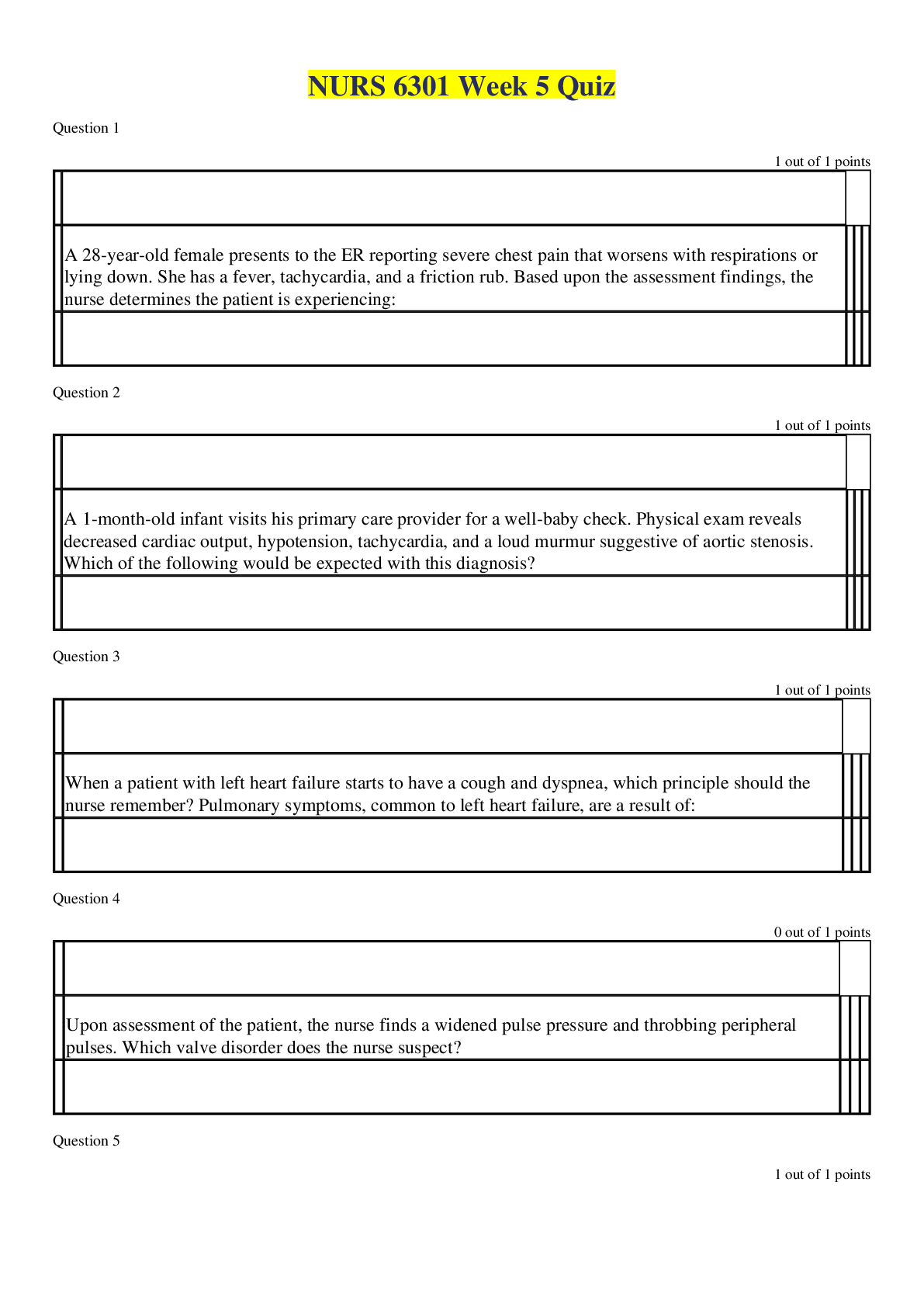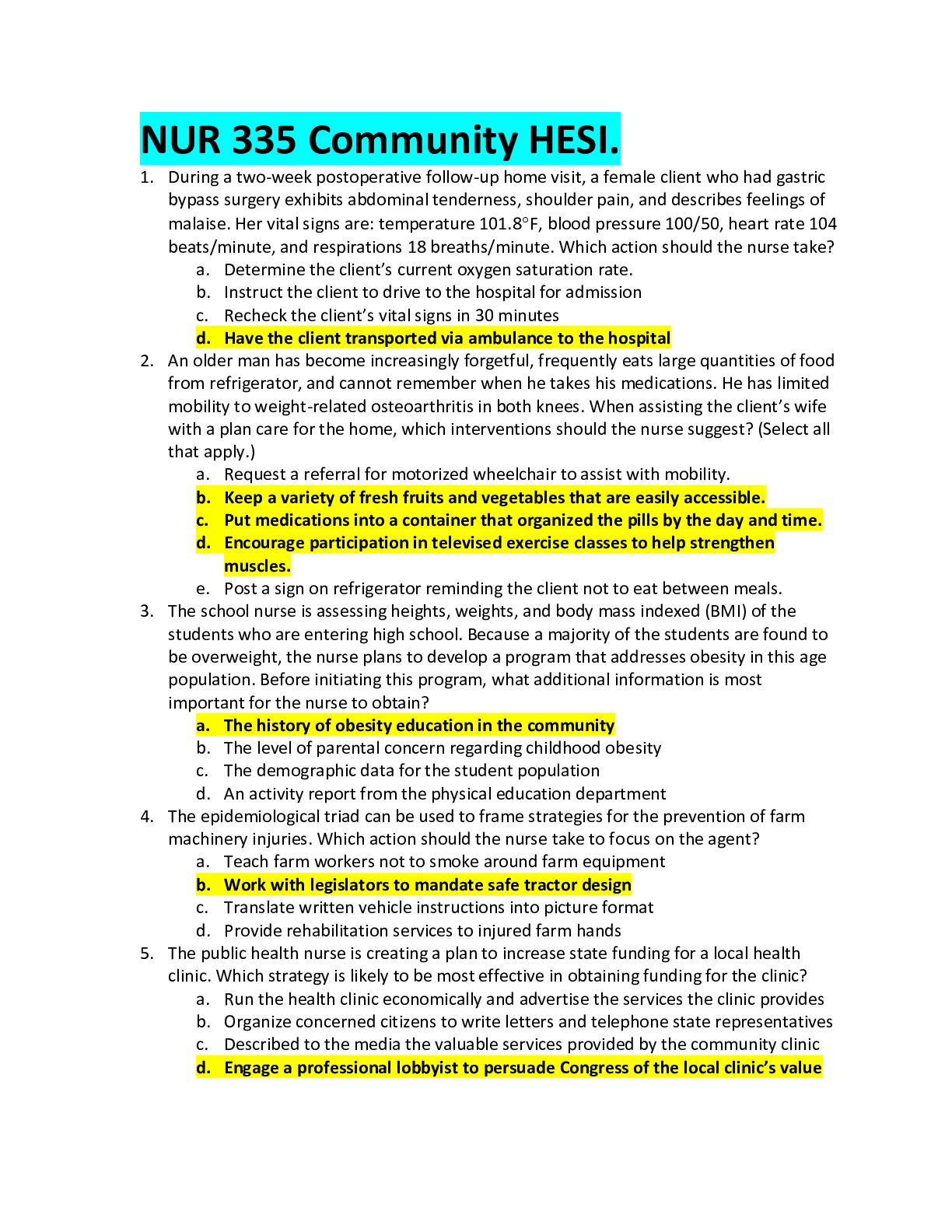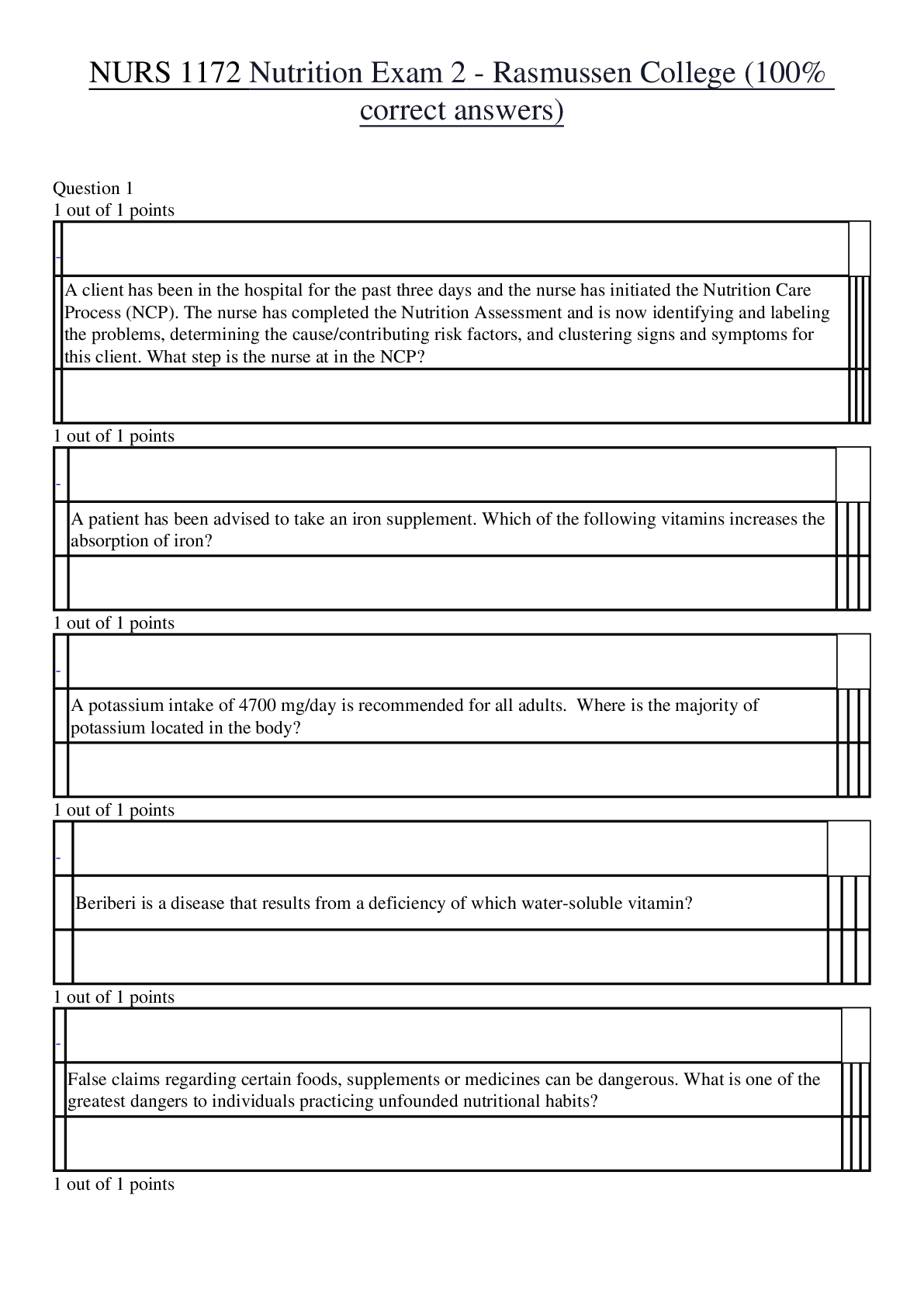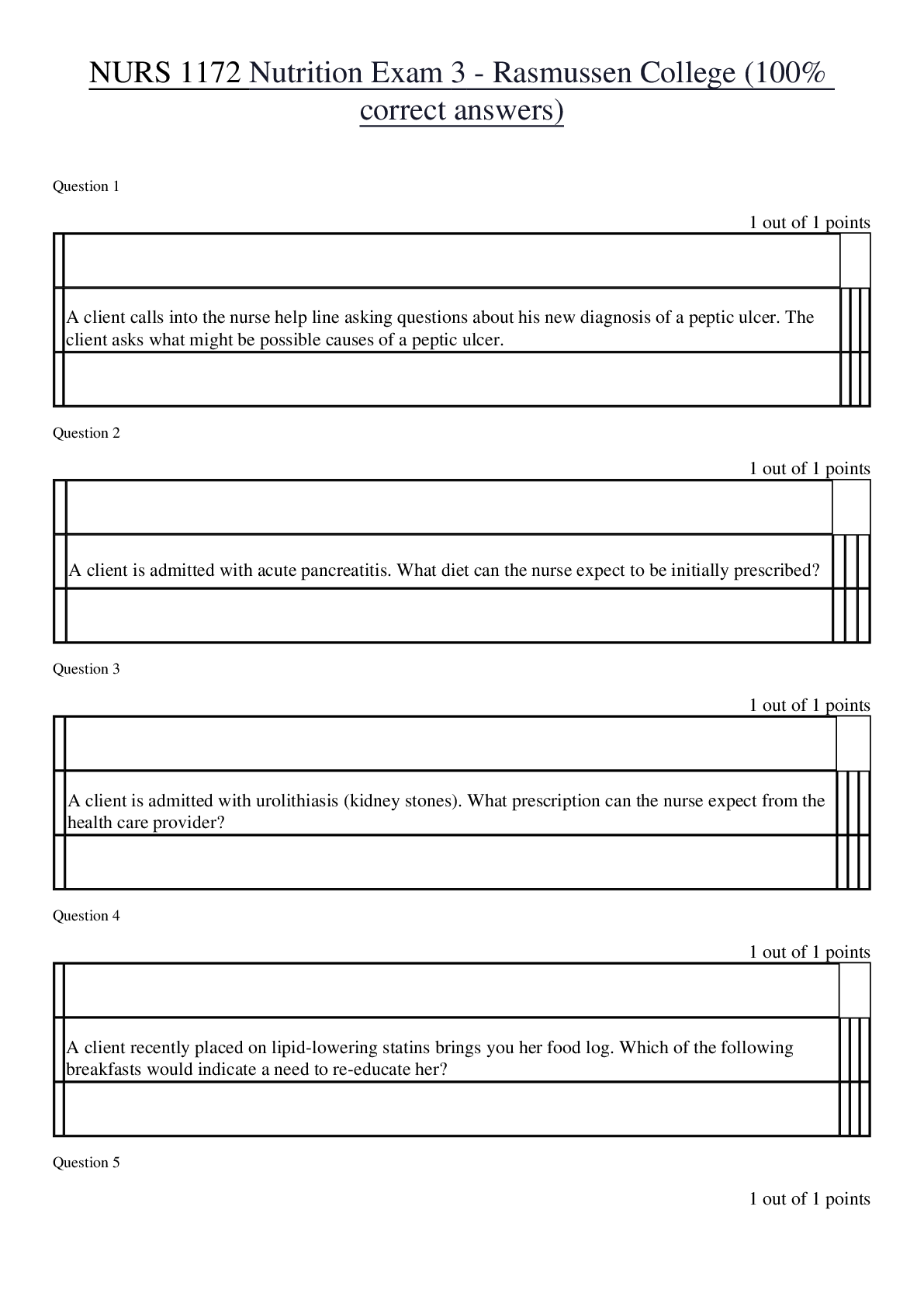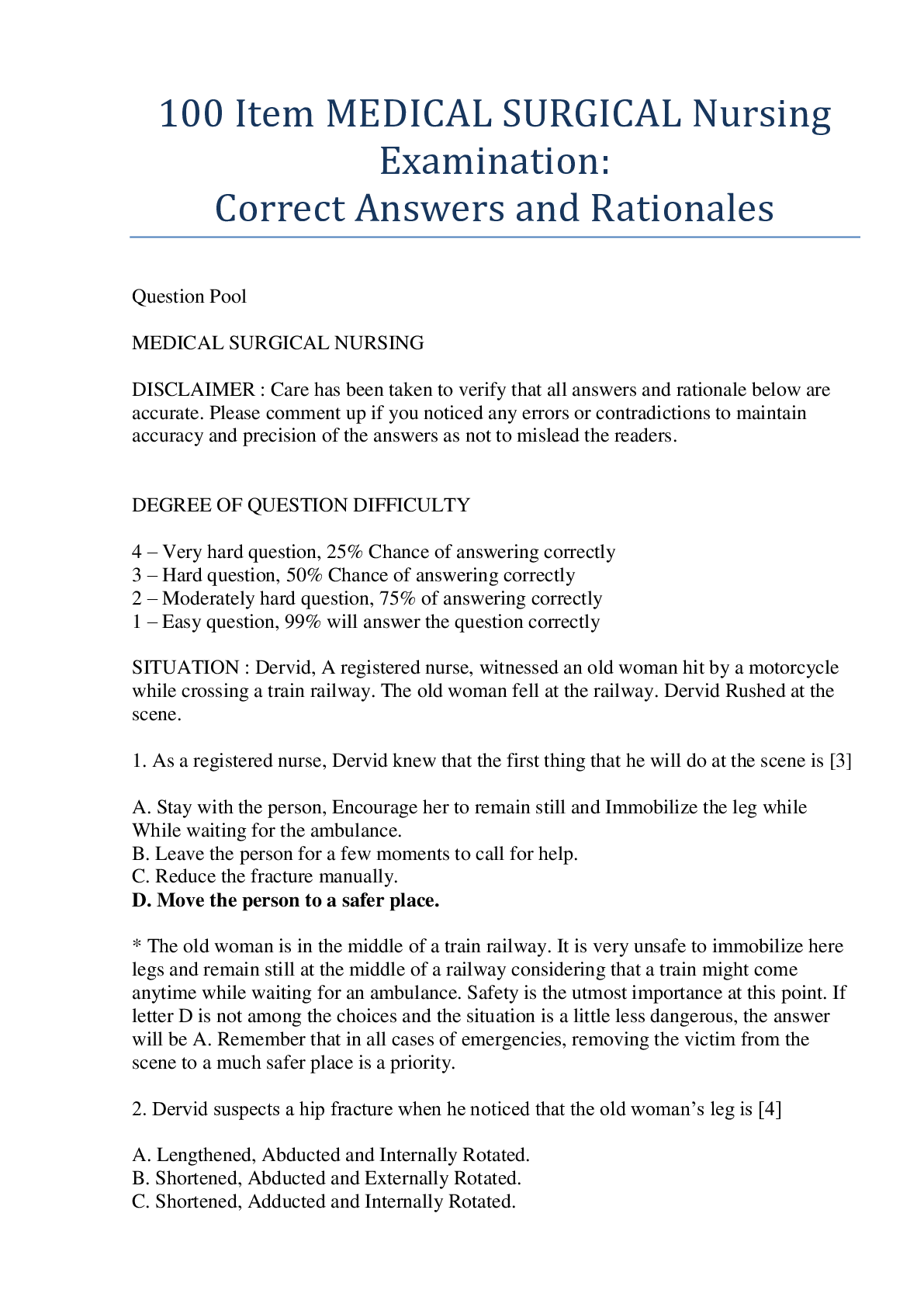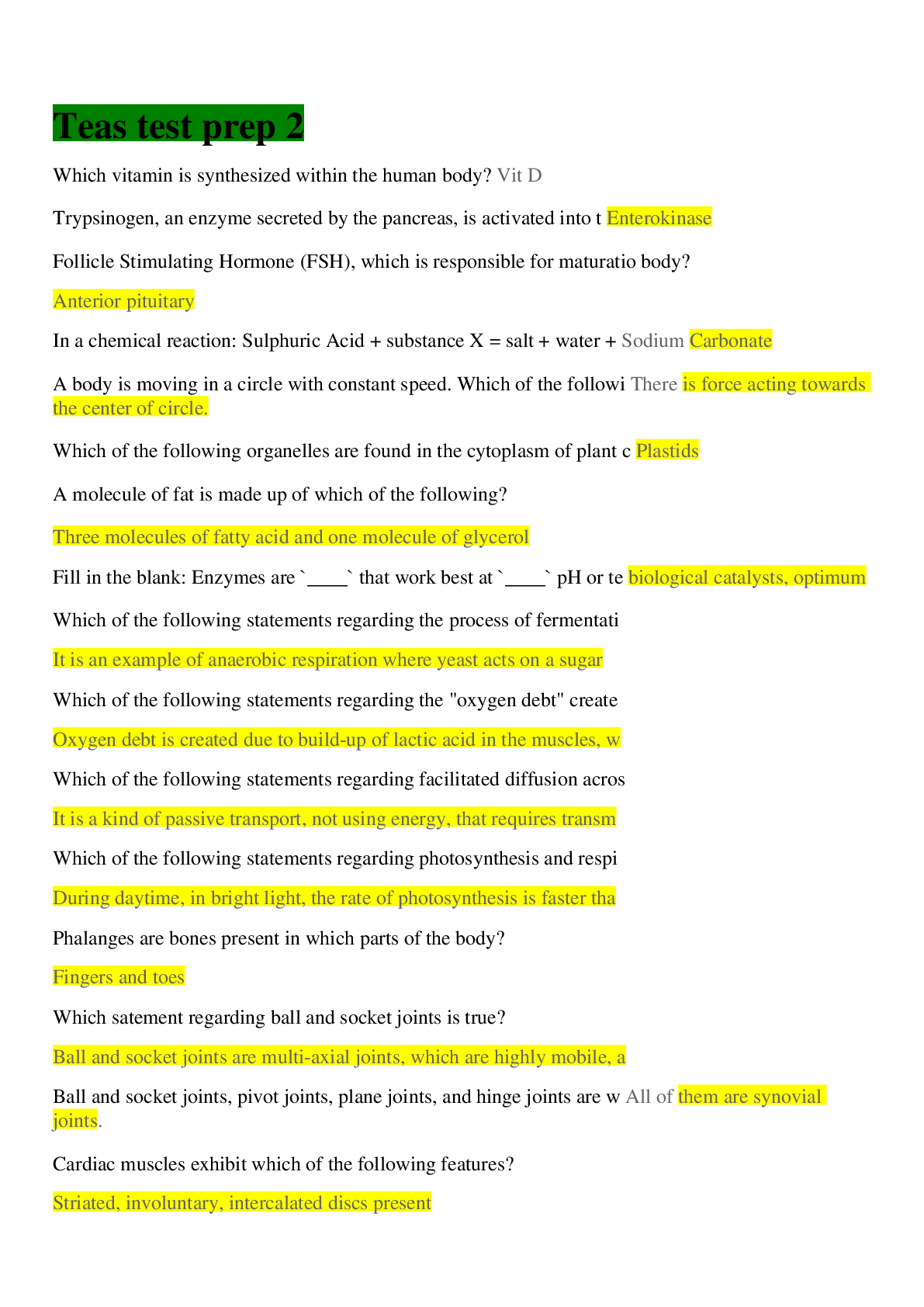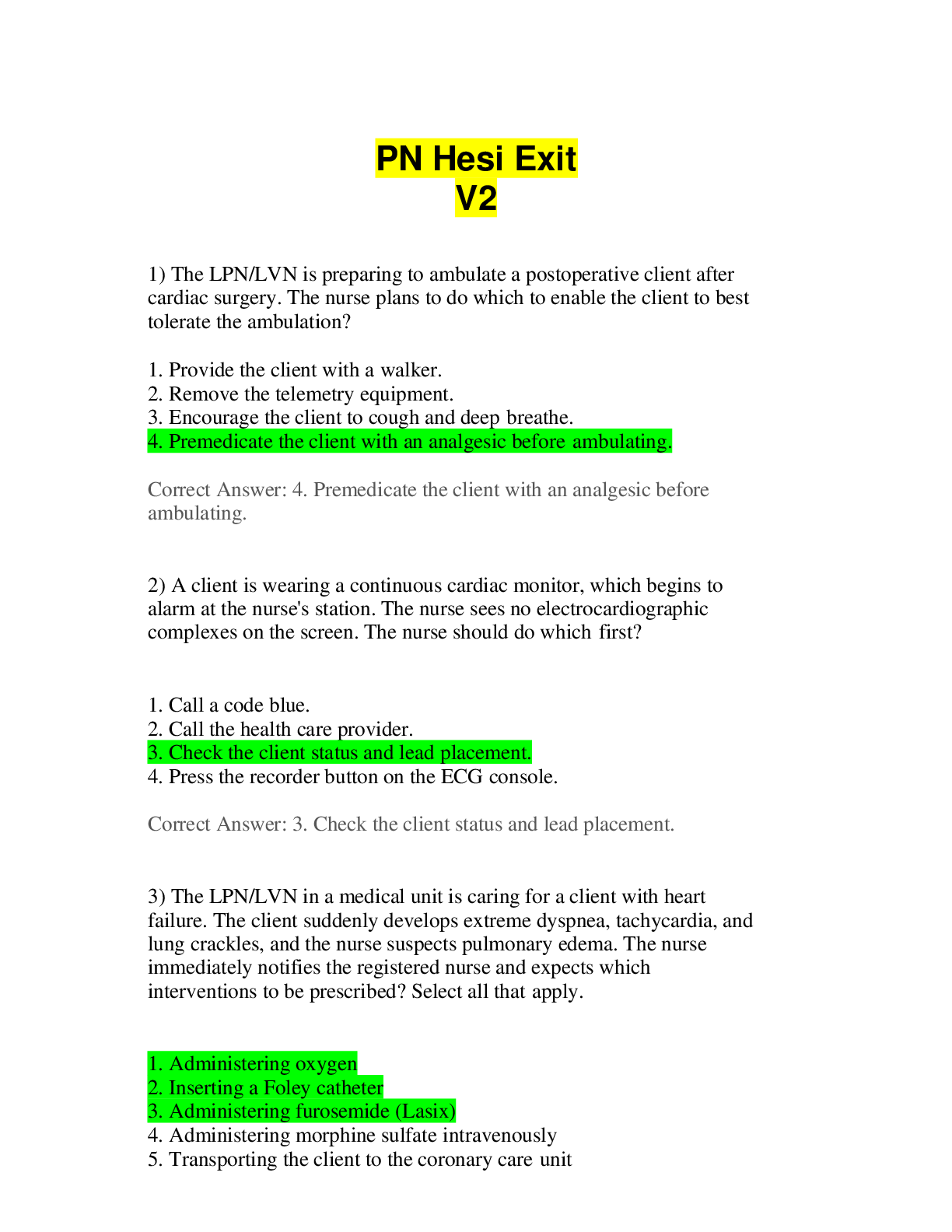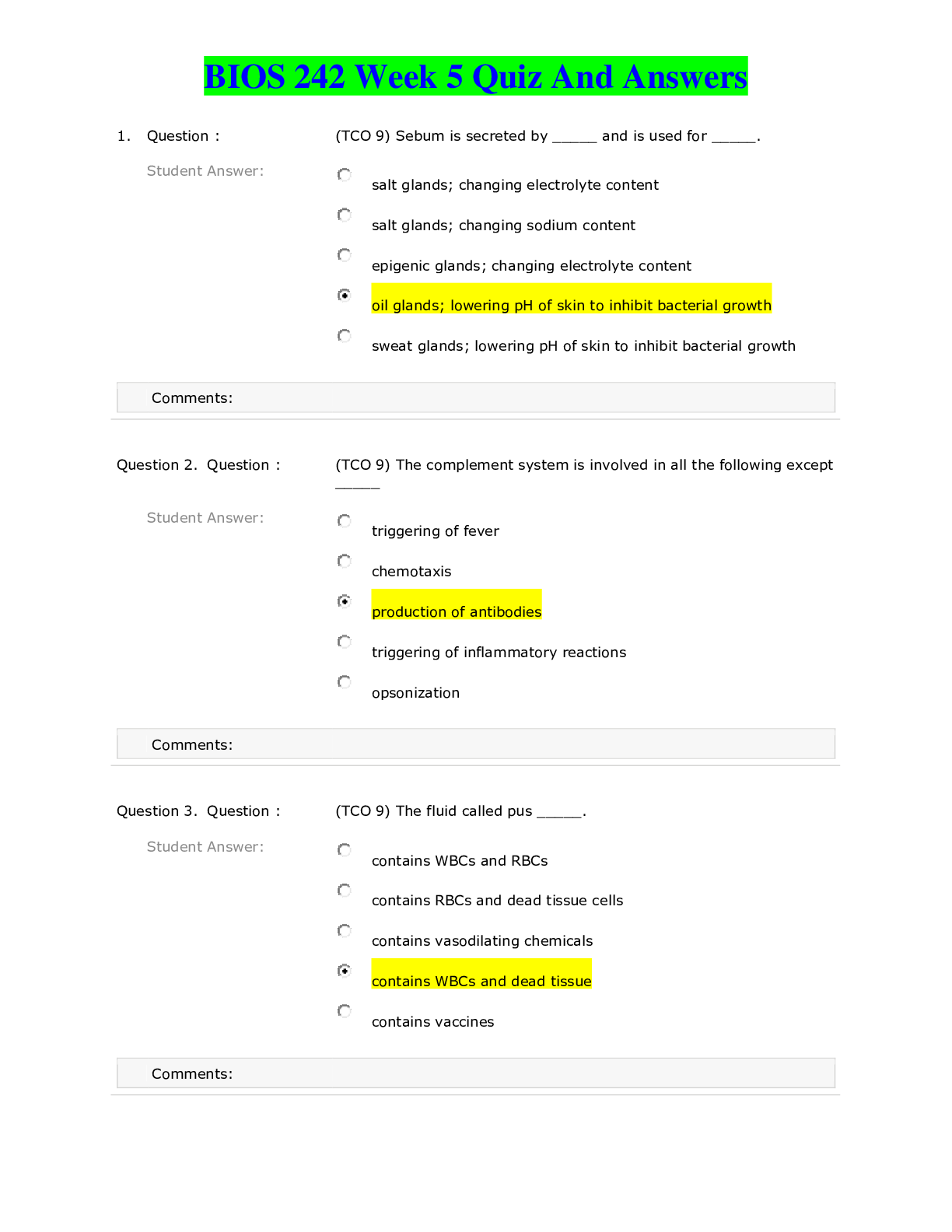*NURSING > EXAM > NSG 6320 AGNP BOARD EXAM QUESTIONS (latest) Prescription of Endocrinology (89 Questions) – South U (All)
NSG 6320 AGNP BOARD EXAM QUESTIONS (latest) Prescription of Endocrinology (89 Questions) – South University Savannah | 100% CORRECT ANSWERS
Document Content and Description Below
NSG 6320 AGNP BOARD EXAM QUESTIONS (latest) Prescription of Endocrinology (89 Questions) – South University Savannah Question: When patients administer regular insulin (Humulin R U-500), they ... should be taught: 5 units of Humulin R U-500 is equal to 10 units on a U-100 insulin syringe. 10 units of Humulin R U-500 is equal to 5 units on a U-100 insulin syringe. 10 units of Humulin R U-500 is equal to 10 units on a U-500 insulin syringe. it should only be used in an insulin pump. Explanation: U-500 insulin is a concentrated form of insulin containing 500 units of insulin per mL. U-500 regular insulin vials are to be used only in conjunction with a dedicated U-500 insulin syringe; dosage conversion is not required with the U-500 syringe. When using a U-100 syringe or a tuberculin syringe to deliver Humulin R U-500 (from vial), a conversion step is required to ensure the amount of Humulin R U-500 is drawn up in the syringe. To avoid dosing errors when using a U-100 insulin syringe, the prescribed dose should be written in actual insulin units and as unit markings on the U-100 insulin syringe (e.g., Humulin R U-500 50 units = 10 units on a U-100 insulin syringe). For safety, ONLY the U-500 syringe should be used. It is not recommended for use in insulin pumps due to possibility of precipitation. Question: Patients taking thiazolidinedione (TZD) medications should be monitored for: diarrhea and flatulence. fluid retention and weight gain. hypotension and dizziness. weight loss and fatigue. Explanation: Thiazolidinediones including pioglitazone hydrochloride (Actos), may precipitate or exacerbate heart failure in some patients by causing dose-related fluid retention. After initiation of pioglitazone tablets, and after dose increases, monitor patients carefully for signs and symptoms of heart failure (e.g., excessive, rapid weight gain, dyspnea, and/or edema). If heart failure develops, pioglitazone should be discontinued or dosage reduced. Pioglitazone tablets are not recommended in patients with symptomatic heart failure. Initiation of pioglitazone hydrochloride in patients with established New York Heart Association (NYHA) Class III or IV heart failure is contraindicated. Question: A patient diagnosed with Type 2 diabetes mellitus has an initial hemoglobin A1C of 7.2%. Assuming no contraindications, the American Diabetes Association's (ADA) initial recommendation for this patient includes: acarbose (Precose). metformin (Glucophage). glipizide (Glucotrol). liraglutide (Victoza). Explanation: Metformin (Glucophage) is the initial recommended pharmacological treatment for type 2 diabetes mellitus, providing there are no contraindications. The other medications have FDA indications as monotherapy for treatment in this patient, but are not as evidence-based as metformin, and thus not initially recommended by ADA. Question: Gynecomastia is NOT likely to be caused by: clonazepam. ketoconazole. lavender oil. marijuana. Explanation: Gynecomastia is not likely to be caused by clonazepam (Klonopin). Ketoconazole, finasteride, spironolactone, lavender oil and tea tree oil are identified as androgens or inhibitors of androgen synthesis and thus are associated with gynecomastia. Alcohol, amphetamines, heroin, marijuana and methadone are also potential medication-related causes of gynecomastia. Question: Which of the following medications may cause gynecomastia? amlodipine (Norvasc). enalapril (Vasotec). losartan (Cozaar). verapamil (Calan). Explanation: Enalapril (Vasotec) and captopril (Capoten) are angiotensin-converting enzyme inhibitors used in the treatment of hypertension. They may cause gynecomastia. Question: Sodium-glucose co-transporter 2 (SGLT2) inhibitors reduce blood glucose by: increasing insulin sensitivity at the cellular level. increasing urinary glucose excretion. potentiating insulin secretion from the pancreas. suppressing glucagon secretion from the liver. Explanation: Sodium-glucose co-transporter 2 (SGLT2) are transporters of glucose in the kidney's proximal tubules and mediate reabsorption of approximately 90% of the filtered renal glucose load. Sodium-glucose co-transporter 2 (SGLT2) INHIBITORS inhibit this action. Examples include dapagliflozin (Farxiga), canagliflozin (Invokana), and empagliflozin (Jardiance). These SGLT2 inhibitors decrease renal uptake of glucose and promote renal excretion of glucose by lowering the renal threshold for glucose. Thus, more glucose is excreted. This modestly lowers elevated blood glucose levels in patients with type 2 diabetes. Question: A patient who is started on a glucagon-like peptide (GLP-1), such as Victoza, should be informed that this class of medications may: increase satiety. cause hypoglycemia. cause weight gain. are inexpensive. Explanation: Advantages of glucagon-like peptide (GLP-1) incretin mimetics such as Byetta, Victoza, Trulicity, and others include that they delay gastric emptying, increase satiety and promote weight loss. The disadvantages are that they must be injected, are expensive, and the long-term effects are not known. Question: The most frequent side effect of metformin (Glucophage) is: diarrhea. hypoglycemia. heartburn. constipation. Explanation: The most frequent side effect of metformin (Glucophage) is gastrointestinal upset; including diarrhea, nausea and flatulence. These symptoms are usually dose dependent and may be alleviated by decreasing the dose, prescribing a once-daily formulation, or administering the medication at nighttime. Question: Patients taking dipeptidyl-peptidase-4 (DDP-IV) inhibitors for the treatment of Type 2 diabetes do NOT routinely need to be monitored for: pancreatitis. severe joint pain. skin exfoliation. weight loss. Explanation: Dipeptidyl-peptidase-4 (DDP-IV) inhibitors including sitagliptin (Januvia); saxagliptin (Onglyza) and linagliptin (Tradjenta) are used in the treatment of Type 2 diabetes. They are NOT likely to cause weight loss or weight gain or risk of hypoglycemia (in the absence of concomitant treatment with insulin or sulfonylureas). Anaphylaxis, angioedema, and exfoliative skin conditions including Stevens-Johnson syndrome, severe and disabling arthralgia and acute pancreatitis (sometimes fatal) syndrome have been reported. Question: A patient who has Addison's disease has received a prescription for fludrocortisone. Fludrocortisone acts by: suppressing immunity. increasing inflammation. regulating salt and water balance. preventing the breakdown of glucose. Explanation: Fludrocortisone is a mineralocorticoid. It is indicated as partial replacement therapy for patients who have primary or secondary adrenocortical insufficiency in Addison's disease. Question: A 63-year-old woman with Type 2 diabetes mellitus has been treated with metformin (Glucophage) for the past 3 months. Baseline estimated glomerular filtration rate was 63. Renal function on this patient should be checked: every 6 months regardless of baseline estimated glomerular filtration rate. every 6 months when estimated glomerular filtration rate is >60. at least annually when estimated glomerular filtration rate is 60 or greater. every 3 months when estimated glomerular filtration rate is less than 80. Explanation: Renal function studies for patients receiving metformin (Glucophage) should be performed annually when eGFR is 60 or greater; every 3-6 months for eGFR between 45-59; and every 3 months for eGFR between 30-44. Metformin (Glucophage) should not be initiated on a patient with a baseline eGFR between 30-44, but should be monitored closely if renal function decreases and falls within that range. It should be discontinued when eGFR falls below 30. Question: Because of the mechanism of action, patients should be instructed to administer exenatide (Byetta): daily at bedtime. immediately following the largest meal of the day. twice daily, within 1 hour prior to morning and evening meals. at least 12 hours apart, regardless of meals. Explanation: Patients should be instructed to administer exenatide (Byetta) within 60 minutes prior to the morning and evening meal (or prior to the 2 main meals of the day). Injections should be administered approximately =6 hours apart. Byetta should NOT be administered after a meal. Extended-release exenatide (Bydureon) is administered weekly. Question: A patient has type 2 diabetes and takes NPH insulin. If his blood glucose values are elevated before the evening meal, when should additional NPH insulin be given? At breakfast 1 hour after breakfast 1 hour before lunch With lunch Explanation: To decrease elevated blood glucose levels before dinner, additional units of NPH should be administered at breakfast. An NPH insulin (Novolin N) is an intermediate-acting insulin. The effects of Novolin N start working 1½ hours after injection. The greatest blood sugar-lowering effect occurs 4 to 12 hours after the injection. This blood sugar lowering may last up to 24 hours. Question: Which of the following is a rapid-acting insulin? Aspart (NovoLog) Glargine (Lantus) NPH (Humulin N) Regular (Humulin R) Explanation: Aspart (NovoLog) is a rapid-acting insulin. The onset of action is about 15 minutes. Lantus is a long-acting insulin for once-daily use. Lantus is slowly released after injection and results in no pronounced or appreciable peak. This allows for once-daily use. NPH insulin is an intermediate-acting insulin with a slow onset of action and longer duration than regular insulin. Regular insulin is a short-acting insulin with onset of action in about 30 minutes. Its maximum effect occurs at about 3 hours and terminates after approximately 8 hours. Question: Pioglitazone hydrochloride (Actos) is contraindicated in patients with: Crohn's disease. heart failure. interstitial cystitis. osteoporosis. Explanation: Pioglitazone hydrochloride (Actos) is contraindicated in patients with established NYHA Class III or IV heart failure because it can cause dose-related fluid retention. It should not be initiated in patients with active bladder cancer and used cautiously in patients with a history of bladder cancer. While osteoporosis is not a contraindication, an increased risk of fractures is reported in women taking pioglitazone and measures to promote and maintain bone health should be considered. No contraindication is listed for Crohn's disease or interstitial cystitis. Question: A patient who has Type 2 diabetes has a history of heart failure. He takes aspart (NovoLog) daily. Which drug class, in combination with Novolog, will significantly increase his risk of heart failure? Atypical antipsychotics Biguanides Sulfonylureas Thiazolidinediones Explanation: Thiazolidinediones (TZDs), like pioglitazone (Actos) and rosiglitazone (Avandia), are peroxisome proliferator-activated receptor (PPAR)-gamma agonists. They can cause dose-related fluid retention, particularly when used in combination with insulin, including NovoLog. Fluid retention may lead to or exacerbate heart failure. Black box warnings related to possible heart failure exist in the literature for pioglitazone and rosiglitazone (the "glitazones"). Question: A 48-year-old patient is started on metformin (Glucophage) for Type 2 diabetes (T2DM). The maximum expected hemoglobin A1C reduction after initiation of this medication is: 0.5%. 1%. 2%. 3%. Explanation: The maximum expected hemoglobin A1C reduction for patients who take metformin (Glucophage) at the higher dose range is approximately 2%. The usual expected decrease (depending on dose) in A1C is 1-2%. Metformin decreases hepatic glucose production, decreases intestinal absorption of glucose, and improves insulin sensitivity by increasing peripheral glucose uptake and utilization. With metformin therapy, insulin secretion remains unchanged while fasting insulin levels and day-long plasma insulin response may actually decrease. It is the initial recommended pharmacological treatment for (T2DM), providing there are no contraindications. Question: Signs and symptoms of hypoglycemia may be blunted by: beta-blockers. calcium-channel blockers. diuretics. thyroid hormones. Explanation: Classically, hypoglycemia is evidenced by shakiness or jitteriness in a patient who is experiencing hypoglycemia. Beta blockers mask these signs by inhibiting these symptoms. Hence, diabetics who take beta blockers may not experience these signs of hypoglycemia and should be taught to watch for diaphoresis. Beta blockers do not affect diaphoresis. Early warning symptoms of hypoglycemia may be different or less pronounced under certain conditions, such as longstanding diabetes, diabetic neuropathy, use of medications such as beta-blockers, or intensified glycemic control. These situations may result in severe hypoglycemia (and, possibly, loss of consciousness) prior to the patient’s awareness of hypoglycemia. Question: Patients receiving atenolol (Tenormin) for symptomatic management of hyperthyroidism should be advised that: this is a lifelong therapy. it should be slowly tapered once euthyroid is obtained. it must be taken at the same time as methimazole. tremulousness and anxiety will require additional therapy. Explanation: Beta-blockers ameliorate the symptoms of hyperthyroidism that are caused by increased beta-adrenergic tone. These include palpitations, tachycardia, tremulousness, anxiety, and heat intolerance. Beta-blockers may be slowly tapered and discontinued once a euthyroid state is obtained. Atenolol and methimazole do not have to be administered at the same time to be therapeutic. Question: A patient is receiving a fast-acting insulin to decrease post-prandial blood sugars. If the bedtime blood sugar is elevated, the patient should be advised to increase the fast-acting insulin dose at: breakfast. lunch. dinner. bedtime. Explanation: To decrease elevated bedtime blood glucose levels, a rapid-acting insulin should be administered at dinner. A common reason for elevated glucose levels before lunch, dinner or bedtime may be that too little short- or rapid-acting insulin was administered at the previous meal. The onset of action of rapid-acting insulins is about 15 minutes. Examples of rapid-acting insulins are insulin glargine (Apidra), Aspart (NovoLog) and Lispro (Humalog). Rapid-acting insulins are administered in conjunction with meals and are used in conjunction with intermediate- or long-acting insulin to control blood glucose in adults and children who have diabetes mellitus. Question: Prior to the administration of methimazole (Tapazole), the nurse practitioner should obtain a baseline: electrocardiogram. complete blood count. iodine level. electrolyte panel. Explanation: Prior to initiating thionamides, such as methimazole (Tapazole), for hyperthyroidism, baseline blood tests including a complete blood count (white count with differential) and a liver profile (bilirubin and transaminases) should be obtained. Thionamides should not be used in patients with a baseline absolute neutrophil count <1000 cells/microL or elevated liver transaminases greater than three times the upper normal limit. Major adverse reactions include agranulocytosis, granulocytopenia, thrombocytopenia, aplastic anemia, drug fever, a lupus-like syndrome, insulin autoimmune syndrome (which can result in hypoglycemic coma), hepatitis (jaundice may persist for several weeks after discontinuation of the drug), periarteritis, and hypoprothrombinemia. Nephritis occurs rarely. Question: Sulfonylureas such as glyburide (Micronase) are extensively metabolized: in the small intestine. by the renal nephrons. in the liver. by beta cells in the pancreas. Explanation: Most sulfonylureas, including glyburide (Micronase), are extensively metabolized in the liver, primarily by the cytochrome P450 (CYP 450) 2C9 isoenzyme. Question: Which of the following medication classes should be avoided in patients with Type 2 diabetes mellitus and a comorbidity of moderate to severe heart failure? Biguanide Thiazolidinediones Glucagon-like peptide (GLP-1) Sulfonylurea Explanation: Thiazolidinediones such as Avandia and Actos should be avoided in patients with moderate to severe heart failure. They can cause dose-related fluid retention, particularly when used in combination with insulin. Fluid retention may lead to or exacerbate heart failure. Question: Insulin detemir (Levemir): has a longer duration of action than insulin glargine (Lantus). may be used in insulin pumps. may be administered once or twice daily. is indicated as monotherapy for patients with Type 1 diabetes mellitus. Explanation: Insulin detemir (Levemir) is a recombinant human insulin analog for once- or twice-daily subcutaneous administration. Patients treated with Levemir once-daily should administer the dose with the evening meal or at bedtime. Patients who require twice-daily dosing can administer the evening dose with the evening meal, at bedtime, or 12 hours after the morning dose. Insulin glargine (Lantus) has exhibited a longer duration of action than insulin detemir in clinical trials. Long-acting insulins are not recommended for use in insulin pumps. Levemir may be used in combination with a rapid- or short-acting insulin for patients with Type 1 diabetes mellitus. It is not indicated as monotherapy in these patients. Question: Patients receiving insulin detemir (Levemir) are at higher risk for developing: hypocalcemia. hypernatremia. hypokalemia. hypermagnesemia. Explanation: Insulin (especially IV insulin) causes a shift of potassium from the extracellular space to the intracellular space, possibly producing hypokalemia. If left untreated, hypokalemia may result in respiratory paralysis, ventricular arrhythmia and even death. Use with caution in patients at risk for hypokalemia (e.g., loop diuretic use). Monitor serum potassium and supplement potassium when necessary. Question: The medication that provides the greatest potential reduction in hemoglobin A1C levels is: basal insulin. dipeptidyl-peptidase-4 (DDP-4). glucagon-like peptide (GLP-1). Sodium-glucose co-transporter 2 (SGLT2) inhibitors. Explanation: The medication that provides the greatest potential reduction in hemoglobin A1C levels is basal insulin. Depending upon the regimen and type of insulin, a potential 3.5% reduction in hemoglobin A1C levels exists. The others may produce a 0.6%-1.5% reduction in hemoglobin A1C levels. Question: Synthroid is a thyroid medication used to treat hypothyroidism. It contains a synthetic form of: triiodothyronine (T3) and levothyroxine (T4). triiodothyronine (T3). levothyroxine (T4). thyroid-stimulating hormone (TSH). Explanation: Synthroid is a synthetic form of levothyroxine used to treat hypothyroidism. T4 (thyroxine) is one of two major thyroid hormones produced by the thyroid gland. The other hormone is T3 (triiodothyronine). The most common cause of hypothyroidism is an autoimmune disorder called Hashimoto's thyroiditis. When an insufficiency of thyroid hormone exists, it is treated with an oral form of levothyroxine. Synthroid is an example of this. Question: Alpha-glucosidase inhibitors such as acarbose (Precose) are contraindicated in patients with: benign prostatic hypertrophy. heart failure. hepatic insufficiency. inflammatory bowel disorders. Explanation: Alpha-glucosidase inhibitors (i.e., Acarbose [Precose] and miglitol [Glyset]) are antidiabetic agents that delay the absorption of carbohydrates following a meal. They are metabolized, absorbed and excreted through the intestinal tract. The most common side effects are GI-related due to the presence of undigested carbohydrates in the lower GI tract. Therefore, these medications are contraindicated in patients with inflammatory bowel disease; colonic ulceration; partial intestinal obstruction or predisposition to intestinal obstruction; chronic intestinal diseases associated with marked disorders of digestion or absorption; and with conditions that may deteriorate as a result of increased gas formation in the intestine. Question: Patients who use insulin glargine (Lantus) should be advised: to inspect for visible particles or color change before administration. that hypoglycemia is not a concern with long-acting insulins. to store unused, unopened vials or prefilled pens in the freezer. that it is ok to mix with another insulin to avoid multiple sticks. Explanation: Patients should be advised to inspect the Lantus vial for visible particles or color change before administration. Lantus is a colorless solution. If the color has changed or there are visible particles, the patient should discard the vial. Lantus should never be frozen. Unopened or unused vials may be refrigerated. If it is frozen, it should be discarded. It should never be diluted or mixed with any other insulin or solution. If the patient is receiving another injectable treatment for diabetes, it may be administered in the same body region but the injections should not be adjacent to each other. Question: A patient who has Type 2 diabetes has consistently elevated blood sugars before lunch. When should a fast-acting insulin be added to this patient's regimen? With breakfast 1 hour after breakfast 1 hour before lunch With lunch Explanation: To decrease elevated pre-lunch blood glucose levels, a rapid-acting insulin could be administered at breakfast. A common reason for elevated glucose levels before lunch, dinner or bedtime is too little short- or rapid-acting insulin at the previous meal. Therefore, if the pre-lunch blood sugar is consistently elevated, the rapid-acting insulin at breakfast may need to be increased. The onset of action of rapid-acting insulins is about 15 minutes. Examples of rapid-acting insulins are insulin glulisine (Apidra), Aspart (NovoLog) and Lispro (Humalog). Rapid-acting insulins are administered in conjunction with meals and are used in conjunction with intermediate- or long-acting insulin to control blood glucose in adults and children who have diabetes mellitus. Question: Insulins recommended for use in insulin pump delivery systems include: Humulin R and glargine. Novolin N and Humalog. Apidra and Humalog. Novolin 70/30 and Novolog. Explanation: Only rapid-acting insulins such as Humalog, Novolog and Apidra are safe to use for continuous infusion via an insulin pump. Short-, intermediate- and long-acting insulins are not indicated for use in insulin pumps. Question: Radioactive iodine treatment for the permanent treatment of hyperthyroidism is usually administered: subcutaneously daily for 14 days. intravenously over a period of weeks. via laser treatments. orally in a single dose. Explanation: Radioactive iodine is the most widely recommended permanent treatment of hyperthyroidism. Radioiodine is taken by mouth (outpatient) and the majority of patients are cured with a single dose. Radioactive forms of iodine are only absorbed by thyroid cells, resulting in thyroid cells being damaged or destroyed. Because iodine is not absorbed by any other cells in the body, there is very little radiation exposure (or side effects) for the rest of the body. It may take 1 to 2 months before the thyroid gland is destroyed, but the radioiodine is completely gone from the body within a few days. Question: In addition to hemoglobin A1C, patients receiving metformin (Glucophage) should be monitored for: anemia, liver function and calcium levels. liver function, microalbumin and vitamin K levels. renal function, urine ketones and vitamin B12 levels. renal function, liver function and vitamin B12 levels. Explanation: In addition to hemoglobin A1C, patients receiving metformin (Glucophage) should be monitored for renal function (eGFR) prior to therapy initiation and at least annually or more frequently in patients who have, or who are at risk of developing renal impairment. Following oral administration, approximately 90% of the absorbed drug is eliminated via the renal route within the first 24 hours. Monitor vitamin B12 serum concentrations periodically with long-term therapy, since absorption may be impaired with long-term use. Question: Which of the following patients would be at risk for lactic acidosis secondary to metformin (Glucophage) use? A 50-year-old man with asthma A 32-year-old pregnant woman A 40-year-old woman with a 60% ejection fraction A 65-year-old man who is a binge drinker Explanation: Alcohol is known to potentiate the effect of metformin on lactate metabolism. This could result in lactic acidosis. Thus, patients should be warned against excessive alcohol intake, acute or chronic, while taking metformin HCL. A normal ejection fraction (EF) is 55%-70% but a diminished EF, as in the case of a patient who has heart failure, can increase the risk of lactic acidosis. Specifically, patients who have unstable or acute heart failure, who are at risk of hypoperfusion and hypoxemia, are at increased risk for lactic acidosis. Additionally, the risk of lactic acidosis increases with the degree of renal dysfunction and the patient’s age. Question: Which of the following side effects may be caused by methimazole (Tapazole)? Osteoporosis Anxiety Hypothyroidism Supraventricular tachycardia Explanation: Methimazole (Tapazole) can cause hypothyroidism, necessitating routine monitoring of TSH and free T4 levels with adjustments in dosing to maintain a euthyroid state. Other serious adverse reactions to methimazole (Tapazole) may include bone marrow suppression, hepatotoxicity, exfoliative dermatitis, unexplained fever, lupus-like syndrome and vasculitis. Tachycardia may be a symptom related to hyperthyroidism, not the administration of methimazole. Question: Thiazolidinedione (TZD) medications: delay absorption of carbohydrates. increase insulin sensitivity. suppress glucagon secretion. potentiate insulin secretion. Explanation: The thiazolidinediones (e.g., Avandia and Actos), increase insulin sensitivity by acting on adipose, muscle, and liver to increase glucose utilization and decrease glucose production. Two classes of oral hypoglycemic drugs improve insulin action as their primary effect: biguanides (metformin) and thiazolidinediones. Alpha glucosidase inhibitors (like Precose and Glyset) delay absorption of carbohydrates following a meal. Meglitinides (Prandin and Starlix), glucagon-like peptide (GLP-1s Byetta, Victoza, Trulicity, others) and sulfonylureas (glimepiride and glipizide) potentiate the release of insulin from the pancreas. Dipeptidyl-peptidase-4 inhibitors (DPP-4s Januvia, Onglyza, Tradjenta) increase insulin secretion and suppress glucagon secretion. Question: Patients who are receiving radioiodine therapy for hyperthyroidism should be advised to: avoid contact with young children for several days. avoid becoming pregnant during treatment and for 12 months after treatment. expect hair loss over the next 3 months. monitor for laryngeal damage. Explanation: Patients who receive radioiodine have the potential to expose their home and household contacts via saliva and urine due to radiation emitting from their body. Patients must take radiation precautions for several days after treatment, avoiding contact with young children and pregnant women. It may take 1 to 2 months before the thyroid gland is rendered inactive, but the radioactive iodine is completely gone from the body within a few days. Pregnancy should be delayed 4 to 6 months after radioiodine therapy to ensure that hyperthyroidism is successfully cured and hypothyroidism ed prior to conception. Laryngeal damage is possible with surgical removal of the thyroid. Hair loss is not associated with radioiodine therapy. Question: A patient is started on a sulfonylurea (i.e., glyburide). The nurse practitioner informs the patient that sulfonylureas are likely to: cause weight loss. reduce microvascular events. delay gastric emptying. reduce the risk of hypoglycemic events. Explanation: The advantages of sulfonylureas such as glyburide (DiaBeta) are that they are low cost, have a long use history, and cause a reduction in micro/macrovascular events. Disadvantages are they produce hypoglycemia and cause weight gain. Glucagon-like peptide (GLP-1) incretin mimetics cause weight loss and delay gastric emptying. Question: Radioiodine therapy is safe to administer to: a 30-year-old-man who desires natural fatherhood. a 32-year-old, 6-week postpartum woman who is breastfeeding. a 38-year-old woman with severe orbitopathy. a 28-year-old woman in her first trimester of pregnancy. Explanation: Radioiodine in the doses used to treat hyperthyroidism does not cause infertility or birth defects in the offspring of treated patients. Thyroid cells are the only cells in the body that can absorb iodine. Radioactive forms of iodine are absorbed by thyroid cells, resulting in thyroid cells being damaged or killed. Because iodine is not absorbed by any other cells in the body, there is very little radiation exposure (or side effects) for the rest of the body. Radioiodine for patients with moderate to severe orbitopathy is not recommended. Severe orbitopathy may be related to Graves' disease, and radioiodine may worsen the condition. Pregnancy and breastfeeding are absolute contraindications to radioiodine therapy, since the fetus or infant's thyroid gland would be affected. Radioiodine should not be given for 6 to 12 weeks after cessation of breastfeeding, to ensure that radioiodine will not be actively concentrated in breast tissue. Question: Undertreatment of hypothyroidism in pediatric patients may lead to: accelerated bone maturation. cretinism. rickets. tremors. Explanation: Cretinism is a congenital disease due to absence or deficiency of normal thyroid secretion. It is characterized by physical deformity, dwarfism, and intellectual disability, and often by goiter. Undertreatment of hypothyroidism in pediatric patients may lead to decreased intellectual development, stunted linear growth and poor school performance due to impaired concentration and slowed mentation. Overtreatment may adversely affect brain maturation, premature closure of the epiphyses, and reduced adult height. Craniosynostosis has been reported in infants. Heat intolerance, weight loss and tremors are related to hyperthyroidism. Rickets is a bone disorder caused by a deficiency of vitamin D, calcium, or phosphate. Pediatric patients should be monitored closely for under/overtreatment of hypothyroidism. Question: Methimazole for the treatment of Graves' disease is contraindicated in patients: with atrial fibrillation. who are younger than 12 years old. who are pregnant. with renal disease. Explanation: Methimazole can cause fetal harm when administered to a pregnant woman. Methimazole readily crosses the placental membranes and can induce goiter and even cretinism in the developing fetus. In addition, rare instances of congenital defects (aplasia cutis, as manifested by scalp defects; esophageal atresia with tracheoesophageal fistula; and choanal atresia with absent/hypoplastic nipples) have occurred in infants born to mothers who received methimazole during pregnancy. Since it is excreted in breast milk, it is contraindicated in lactating mothers. Question: The onset of action of short-acting insulins is: 5 minutes. 15 minutes. 30 minutes. 90 minutes. Explanation: The onset of action of short-acting insulin is 30 minutes. An example of a short acting insulin is regular insulin, Humulin R. Question: A 35-year-old woman with Type 2 diabetes mellitus has taken 1000 mg metformin twice daily for the past 3 months. Today's hemoglobin A1C has decreased to 7.8%. An appropriate action today is to: add glimepiride (Amaryl) because this patient does not have health insurance and she is unable to afford a different medication. continue the current dose of metformin for another 3 months before adding another agent. discontinue her metformin and consider a once-daily insulin in the evening. encourage lifestyle modifications (diet and exercise) for another 3 months before adding a second agent. Explanation: The American Diabetes Association recommends the addition of a second medication when the goal A1C (usually <7% in young adults with Type 2 diabetes who are not pregnant) has not been attained in 3 months on a single agent. Metformin is the preferred initial agent. The balance among efficacy in lowering A1C, side effects, and costs must be carefully weighed in considering which medication to choose as a second agent. Sulfonylureas are often chosen because they are of low cost. This patient has no health insurance. Question: A patient with Graves' hyperthyroidism is started on thionamide therapy (methimazole [Tapazole]). The goal is to achieve a euthyroid state within: 24 hours. 72 hours. 7 days. 3 weeks. Explanation: The goal of thionamide therapy (including methimazole and propylthiouracil [PTU]) in Graves' hyperthyroidism is to attain a euthyroid state rapidly in preparation for radioiodine therapy or thyroidectomy. Thionamides take 3 to 8 weeks to produce a euthyroid state because they block NEW hormone synthesis, and any already formed thyroxine (T4) and triiodothyronine (T3) stored in the thyroid or in circulation must be secreted and metabolized before clinical improvement can occur. Patients who want to avoid or defer ablative therapy with radioiodine or surgery can continue the thionamide for prolonged periods. Typically, thionamide therapy is continued for 1 to 2 years with the goal of attaining remission. Question: Alpha-glucosidase inhibitors help to lower serum glucose by: delaying the absorption of carbohydrates. increasing insulin excretion. suppressing glucagon secretion. increasing insulin sensitivity. Explanation: Alpha glucosidase inhibitors such as Acarbose (Precose) and miglitol (Glyset) delay the absorption of carbohydrates following a meal, resulting in a smaller rise in glucose elevation. Sodium-glucose co-transporter 2 (SGLT2) inhibitors reduce blood glucose by increasing urinary glucose excretion. Meglitinides promote insulin release from ß-islet cells of the pancreas. The thiazolidinediones (TZDs), like Avandia and Actos, increase insulin sensitivity by acting on adipose, muscle, and liver to increase glucose utilization and decrease glucose production. Dipeptidyl-peptidase-4 (DDP-4) inhibitors increase insulin secretion and suppress glucagon secretion. Question: An example of a medication that contains a combination of a sulfonylurea and biguanide is: glipizide and metformin. pioglitazone and metformin. repaglinide and metformin. sitagliptin and metformin. Explanation: Glipizide and metformin is a combination sulfonylurea and biguanide. The brand name is Metaglip. Pioglitazone is a thiazolidinedione (TZD) and the brand name when combined with metformin is Actoplus Met. Repaglinide is a meglitinide and when combined with metformin is marketed as PrandiMet. Question: The expected hemoglobin A1C reduction for patients who are started on a dipeptidyl peptidase-4 (DPP-4) inhibitor such as sitagliptin (Januvia) is: 0.6%. 1.0%. 1.5%. 2%. Explanation: Dipeptidyl-peptidase-4 (DDP-4) inhibitors increase insulin secretion and suppress glucagon secretion. DDP-4 inhibitors also referred to as “gliptins” and include sitagliptin (Januvia), saxagliptin (Onglyza), and linagliptin (Tradjenta). The expected hemoglobin A1C reduction for patients who are started on a dipeptidyl peptidase-4 (DPP-4) inhibitor ("gliptins") or incretin enhancer is about 0.5 to 0.6%. Question: Metformin (Glucophage) is a: biguanide. sulfonylurea. DPP-4 inhibitor. thiazolidinedione. Explanation: Metformin (Glucophage) is a biguanide and the only one currently on the market. An example of a sulfonylurea is glipizide (Glucotrol). An example of a DPP-4 is linagliptin (Tradjenta). An example of a thiazolidinedione (TZD) is rosiglitazone (Avandia) or pioglitazone (Actos). Question: Which of the following medications is NOT a potential cause of gynecomastia? cimetidine (Tagamet). omeprazole (Prilosec). pantoprazole (Protonix). ranitidine (Zantac). Explanation: Among the H2 histamine receptor blockers, cimetidine (Tagamet) seems to be the one that most frequently causes gynecomastia. Reports of gynecomastia associated with omeprazole (Prilosec) and ranitidine (Zantac) are much less common, but have been reported. Question: The generic name for Victoza is: exenatide. liraglutide. nateglinide. sitagliptin. Explanation: The generic name for Victoza is liraglutide. Victoza and exenatide (Byetta) belong to a class of medications termed GLP-1 agonists. Nateglinide is the generic name for Starlix, in the drug class meglitinides. Sitagliptin (Januvia) a DDP-4 inhibitor. These medications are used in the treatment of Type 2 diabetes mellitus. Question: DPP IV inhibitors such as alogliptin (Nesina): decrease hepatic glucose production. decrease intestinal absorption of glucose and improve insulin sensitivity suppress glucagon secretion and increase insulin secretion. stimulate the release of insulin from functioning pancreatic beta cells. Explanation: DPP IV inhibitors, the "gliptins," inhibit dipeptidyl peptidase-4, slow incretin metabolism, increase insulin synthesis and release, and decrease glucagon levels. Sulfonylurea agents such as glimepiride (Amaryl) stimulate the release of insulin from functioning pancreatic beta cells. Biguanides such as metformin (Glucophage) decrease hepatic glucose production, decrease intestinal absorption of glucose, and improve insulin sensitivity. Question: The mechanism of action of methimazole (Tapazole) is to: inactivate circulating T4 and T3. block synthesis of thyroxine and triiodothyronine (T3). increase the oxidation of iodine in the thyroid gland. decrease the production of thyroid-stimulating hormone in the pituitary. Explanation: Methimazole (Tapazole) inhibits the synthesis of thyroid hormones by blocking the oxidation of iodine in the thyroid gland and blocking the synthesis of thyroxine and triiodothyronine (T3), but it does not inactivate circulating T4 and T3. Methimazole is readily absorbed in the gastrointestinal tract, metabolized in the liver, and excreted in the urine. Question: Victoza (liraglutide), a glucagon-like peptide-1 for the treatment of Type 2 diabetes, may potentially decrease the effectiveness of: oral contraceptives. selective serotonin reuptake inhibitors (SSRIs). sulfonylureas. vitamin K antagonists. Explanation: Liraglutide (Victoza), a glucagon-like peptide-1 (GLP-1) for the treatment of Type 2 diabetes, may potentially decrease the effectiveness of oral contraceptives because GLP-1 medications delay absorption of orally absorbed medications. Patients should be informed to take oral contraceptives at least 1 hour prior to administering exenatide. SSRIs act synergistically and may increase the hypoglycemic effect of liraglutide. Thus, there is an increased risk of hypoglycemia when liraglutide is combined with any sulfonylurea (i.e., glyburide). A dose reduction of sulfonylurea should be considered when used in combination with a GLP-1 agonist. Liraglutide may increase the anticoagulant effect of vitamin K antagonists such as warfarin (Coumadin). Question: Which of the following is an intermediate-acting insulin? Insulin glulisine (Apidra) Insulin lispro (Humalog) Insulin NPH (Humulin N) Insulin glargine (Toujeo) Explanation: Humulin N is an intermediate-acting insulin with 1-2 hour onset of action, 6-12 hour peak and 18-24 hour duration. Apidra is a fast-acting insulin with 0.25-hour onset, 1 hour peak and 2-4 hour duration. Humalog is also fast-acting with less than 0.25-hour onset, 1 hour peak and 3.5-4.5 hours duration. Toujeo is a long-acting insulin with an onset that develops over 6 hours, no peak and a 24-hour duration. Question: A 55-year-old obese woman with Type 2 diabetes mellitus has been receiving metformin and glimepiride daily at highest tolerated doses. Her most recent hemoglobin A1C is 9.0%. How should this be managed? Pioglitazone (Actos) should be added to the regimen. A rapid-acting insulin should be initiated at mealtime. Add a long-acting insulin at bedtime, continue metformin, and discontinue the glimepiride. Add a long-acting insulin at bedtime and continue the metformin and glimepiride. Explanation: For patients who are not well controlled on two oral agents, switching to insulin is usually less expensive than adding a third oral or injectable agent. The balance among efficacy in lowering A1C, side effects, and costs must be carefully weighed when considering which drugs or combinations to choose. An intermediate or long-acting insulin is preferred for patients with A1C >8.5% or with symptoms of hyperglycemia. The addition of pioglitazone (Actos) could be considered if the A1C were closer to goal. Additionally, the addition of a third oral agent may increase the potential for side effects. While diet and exercise should be addressed at each visit, to reduce the potential long-term complications of diabetes, an additional agent should be added. Question: Joe is a 50-year-old diabetic. He took Humulin R-100 6 hours ago, prior to lunch. He is now going to work out. With regard to hypoglycemia during exercise, Joe should: not be concerned, because the duration of Humulin R-100 is only 4 hours. check blood sugar. As long as it is >100 mg/dL, he should not be concerned. have a fast-acting, 15-20 g carbohydrate snack available if needed. avoid exercising until the Humulin R-100 has peaked at 8 hours. Explanation: People with type 2 diabetes who take insulin or an insulin secretagogue are likely to have issues with hypoglycemia during or after exercise. The peak of Humulin R-100 is 2-4 hours with a duration of 5-8 hours. Potentially, Joe could experience hypoglycemia because his exercise is within the duration of the insulin's action and exercise increases insulin sensitivity while using glucose for energy. Checking the blood glucose level frequently before and after exercise can help determine the patient's response to exercise. A fast-acting carbohydrate snack of at least 15-20 grams should be readily available in case Joe experiences symptoms of hypoglycemia. Question: Aspart (NovoLog) should be administered: 10 minutes prior to a meal. 30 minutes prior to a meal. 30 minutes after a meal. just before sleep. Explanation: Aspart (NovoLog) is a rapid-acting insulin and should be administered 5-10 minutes prior to a meal. Question: Levothyroxine use in the first trimester of pregnancy: should be discontinued. may require a decrease in dose. may require an increase in dose. will not require dosage adjustment. Explanation: Due to alterations of endogenous maternal thyroid hormones, the levothyroxine dose may need to be increased during the first trimester of pregnancy. After delivery, the dose usually needs to be decreased to its pre-pregnancy dose. Question: A 32-year-old woman is diagnosed with hyperthyroidism. The nurse practitioner knows that initiating a beta-blocker: will slowly increase serum triiodothyronine (T3) concentrations. is not indicated unless the patient has symptomatic tachycardia. decreases beta-adrenergic activity in the tissues, caused by hyperthyroidism. stimulates the conversion of thyroxine (T4) to T3. Explanation: In many tissues, hyperthyroidism is associated with an increased number of beta-adrenergic receptors. These receptors are responsible for increasing beta-adrenergic activity that may cause common symptoms such as palpitations, tachycardia, tremulousness, anxiety, and heat intolerance. If there are no contraindications, beta-blockers should be given in combination with a thionamide. High doses of propranolol, atenolol, alprenolol, and metoprolol cause reductions in serum T3 concentrations (up to 30%) by inhibiting monodeiodinase activity, which converts thyroxine (T4) to T3. These agents cannot be used as lone agents for treatment of hyperthyroidism but are excellent in combination with thionamide. Sotalol and nadolol do not cause a decrease in T3 concentrations and so theoretically are not as effective as the other mentioned beta blockers. Question: Trulicity (dulaglutide) a glucagon-like peptide-1, would be indicated for use in which of the following patients? A 35-year-old with type 2 diabetes in ketoacidosis A 35-year-old patient with type 2 diabetes and morbid obesity An 11-year-old with type 1 diabetes A 52-year-old with type 2 diabetes with severe renal impairment Explanation: Advantages of glucagon-like peptide (GLP-1) incretin mimetics such as dulaglutide (Trulicity), exenatide (Byetta), liraglutide (Victoza), and others include that they delay gastric emptying, increase satiety and promote weight loss. GLP-1 incretin mimetics are indicated as an adjunct to diet and exercise to improve glycemic control in adults with type 2 diabetes. Their use may be associated with weight loss (due to reduced intake) independent of the change in hemoglobin A1C. They are not recommended for use in patients with end-stage renal disease or severe renal impairment (creatinine clearance <30 mL/min) and should be used with caution in older patients with decreased renal function. Safety and effectiveness have not been established in pediatric patients. They are not indicated for the treatment of type 1 diabetes or diabetic ketoacidosis. Question: Sulfonylureas such as glyburide (Diabeta) are expected to reduce the hemoglobin A1C in patients with Type 2 diabetes mellitus by: 0.5%. 1.5%. 2%. 3%. Explanation: The expected hemoglobin A1C reduction for patients who are started on a sulfonylurea is 1% to 2%. Sulfonylurea agents such as glyburide (Diabeta) stimulate the release of insulin from functioning pancreatic beta cells. Question: Maximum plasma concentrations of glucagon, after intramuscular injection, are observed in approximately: 5 minutes. 15 minutes. 30 minutes. 45 minutes. Explanation: The maximum plasma concentration of glucagon, after intramuscular administration to a patient with severe hypoglycemia, are obtained in approximately 13 minutes. With subcutaneous administration, maximum plasma concentrations are achieved in approximately 20 minutes. Glucagon acts only on liver glycogen, converting it to glucose and is extensively degraded in liver, kidney, and plasma. Question: In addition to hypoglycemia, rapid-acting insulins may cause: hyponatremia. hypernatremia. hypokalemia. hyperkalemia. Explanation: All insulin products, including NovoLog, cause a shift in potassium from the extracellular to intracellular space, possibly leading to hypokalemia that, if left untreated, may cause respiratory paralysis, ventricular arrhythmia, and death. Use caution in patients who may be at risk for hypokalemia (e.g., patients using potassium-wasting medications, patients taking medications that are greatly affected by serum potassium concentrations (digoxin), and patients receiving intravenous insulin. Question: The most common serious side effect associated with glimepiride (Amaryl) is: asthenia. diarrhea. hypoglycemia. metallic taste. Explanation: The most commonly reported and serious side effect associated with glimepiride (Amaryl) is hypoglycemia. All sulfonylurea drugs are capable of producing severe hypoglycemia. Hypoglycemia is more likely to occur when caloric intake is deficient, after severe or prolonged exercise, when ethanol is ingested, or when more than one glucose-lowering drug is used. It is also more likely in older adult patients, malnourished patients and in patients with impaired renal or hepatic function. Use with caution. Asthenia, diarrhea and metallic taste are associated with metformin. Question: A patient is started on exenatide (Byetta) for Type 2 diabetes. Byetta should be discontinued if the patient exhibits: persistent abdominal pain, radiating to the back. fluid retention and weight gain. hirsutism and gynecomastia. hypotension and dizziness. Explanation: Patients receiving exenatide (Byetta) should be monitored for symptoms of acute pancreatitis. After initiation and dose increases of Byetta, patients should be observed carefully for symptoms of pancreatitis including persistent severe abdominal pain, sometimes radiating to the back, with or without vomiting. If pancreatitis is suspected, Byetta should be discontinued promptly. It should not be restarted if pancreatitis is confirmed. Prior to initiating Byetta, patients should be assessed for a history of pancreatitis, cholelithiasis, and alcohol use. Question: Glyburide (Diabeta) is a: biguanide. sulfonylurea. meglitinide. thiazolidinedione. Explanation: Metformin (Glucophage) is a biguanide and the only one currently on the market. An example of a sulfonylurea is glyburide (Diabeta). An example of a DPP-4 is linagliptin (Tradjenta). An example of a thiazolidinedione (TZD) is rosiglitazone (Avandia) or pioglitazone (Actos). Question: Many medications can enhance the hypoglycemic effect of sulfonylureas. Which medication class does NOT enhance the hypoglycemic effect of sulfonylureas? Angiotensin-converting enzyme inhibitors Beta-blockers H2 receptor antagonists Thiazide diuretics Explanation: Severe hypoglycemia can occur when sulfonylurea drugs are given concomitantly with angiotensin-converting enzyme inhibitors, beta-blockers, or H2 receptor antagonists. These medications may increase the glucose-lowering effect of sulfonylureas and increase the susceptibility and/or intensity of hypoglycemia. Thiazide diuretics may diminish the glucose-lowering effect of sulfonylureas through an unknown mechanism. Hyperglycemia may result. Question: The mechanism of action by which metformin (Glucophage) improves glucose tolerance is: increased fasting insulin levels. decreased intestinal absorption of glucose. decreased peripheral glucose uptake and utilization. increased insulin secretion. Explanation: Metformin decreases hepatic glucose production, decreases intestinal absorption of glucose, and improves insulin sensitivity by increasing peripheral glucose uptake and utilization. With metformin therapy, insulin secretion remains unchanged while fasting insulin levels and day-long plasma insulin response may actually decrease. Question: Thiazolidinediones (TZDs) such as pioglitazone (Actos) reduce A1C by levels by: 0.7%. 1.5%. 2%. 3%. Explanation: Thiazolidinediones (TZDs) such as pioglitazone (Actos) and rosiglitazone (Avandia) are peroxisome proliferator-activated receptor (PPAR)-gamma agonists. The maximum expected hemoglobin A1C reduction for patients who take a thiazolidinedione is about 0.7%. Question: Levothyroxine (Synthroid) is indicated in the treatment of: hyperthyroidism. hypothyroidism. thyrotoxicosis. weight reduction. Explanation: Levothyroxine (Synthroid), synthetic T4, is indicated in the treatment of hypothyroidism. It is contraindicated in the treatment of hyperthyroidism because an excess of T4 exists when hyperthyroidism is present. Thyrotoxicosis is the term used to describe an excess of thyroid hormone produced by the thyroid gland. Thyroid hormones, including levothyroxine, are not used alone or with other therapeutic agents for the treatment of obesity or for weight loss. In euthyroid patients, doses within the range of daily hormonal requirements are ineffective for weight reduction. Question: Lantus is: insulin degludec with a 40-hour duration and no peak. insulin detemir with a 24-hour duration and no peak. insulin glargine with a 24-hour duration and no peak. insulin lispro with a 12-hour duration and no peak. Explanation: Lantus is insulin glargine. It has an onset of about 1.1 hours, duration of >24 hours and does not peak. Insulin detemir is Levemir and has an onset of about 1 hour, lasts for 24 hours and does not peak. Insulin lispro is a fast-acting insulin with an onset of 5-15 minutes, peaks in 45-75 minutes and has a duration of 2-4 hours. Insulin degludec has an onset of 2 hours, duration of action >40 hours and does not peak. Question: Sulfonylurea agents such as glimepiride (Amaryl): decrease hepatic glucose production. decrease intestinal absorption of glucose and improves insulin sensitivity. slow incretin metabolism, decrease glucagon secretion and increase insulin secretion. stimulate the release of insulin from functioning pancreatic beta cells. Explanation: Sulfonylurea agents such as glimepiride (Amaryl) stimulate the release of insulin from functioning pancreatic beta cells. Biguanides such as metformin (Glucophage) decrease hepatic glucose production, decrease intestinal absorption of glucose, and improve insulin sensitivity. DPP IV inhibitors, the "gliptins" inhibits dipeptidyl peptidase-4, slow incretin metabolism, increase insulin synthesis and release, and decrease glucagon levels. Question: Insulin glargine (Lantus) is NOT indicated in the treatment of: adults with Type 1 diabetes mellitus. adults with Type 2 diabetes mellitus. pediatric patients with Type 1 diabetes mellitus. pediatric patients with Type 2 diabetes mellitus. Explanation: Insulin glargine (Lantus) is a long-acting human insulin analog indicated to improve glycemic control in adults and pediatric patients with type 1 diabetes mellitus and in adults with type 2 diabetes mellitus. The FDA has not approved Lantus for use in children with Type 2 diabetes. Question: What are the benefits of initiating an alpha-glucosidase inhibitors such as acarbose (Precose) for a patient with Type 2 diabetes? They have a low potential for hypoglycemia They are rapidly absorbed They reduce postprandial glucose values They are given once weekly and do not cause weight gain Explanation: Some benefits of alpha-glucosidase inhibitors are: improbable hypoglycemia with monotherapy; weight neutrality; postprandial glucose improvement; reduced cardiovascular disease risk (acarbose); benefit for prediabetes (acarbose); and nonabsorption. Question: Exenatide (Byetta) is classified as: dipeptidyl-peptidase-4 (DDP-4). glargine insulin. glucagon-like peptide (GLP-1). Sodium-glucose co-transporter 2 (SGLT2) inhibitors Explanation: Exenatide (Byetta) is classified as a glucagon-like peptide (GLP-1). Glargine insulin is Lantus. Examples of SGLT-2 inhibitors are Farxiga (dapagliflozin), Invokana (canagliflozin), Jardiance (empagliflozin). Question: The onset of action of rapid-acting insulins is: 5 minutes. 15 minutes. 30 minutes. 45 minutes. Explanation: The onset of action of rapid-acting insulins is about 15 minutes. Examples of rapid-acting insulins are insulin glargine (Apidra), Aspart (NovoLog), Lispro (Humalog). Rapid-acting insulins are administered in conjunction with meals and are used in conjunction with intermediate or long-acting insulin to control blood glucose in adults and children who have diabetes mellitus. Question: Sodium-glucose co-transporter 2 (SGLT2) inhibitors are oral antidiabetic agents and are known to cause: anemia. hypertension. hypoglycemia. weight loss. Explanation: Sodium-glucose co-transporter 2 (SGLT2) inhibitors, such as dapagliflozin (Farxiga) and canagliflozin (Invokana), cause side effects such as weight loss because they cause excretion of 200-400 calories per day in the form of urinary glucose. These medications decrease blood pressure and elevate low density lipoprotein levels. They do not usually cause hypoglycemia unless combined with insulin or insulin secretagogues. Expense, side effects, and limited data on long-term safety should be considered prior to prescribing SGLT2 inhibitors. Question: The mechanism of action for glucagon-like peptide-1 (GLP-1) medications like Byetta, Victoza, Trulicity and others is: delayed absorption of carbohydrates. increased insulin sensitivity. suppressed glucagon secretion. potentiated insulin secretion. Explanation: Glucagon-like peptide-1 (GLP-1) potentiates the release of insulin from the pancreas. Alpha glucosidase inhibitors, such as Precose and Glyset, delay absorption of carbohydrates following a meal. The thiazolidinediones (TZDs), such as Avandia and Actos, increase insulin sensitivity by acting on adipose, muscle, and liver to increase glucose utilization and decrease glucose production. Dipeptidyl-peptidase-4 (DDP-4) inhibitors increase insulin secretion and suppress glucagon secretion. Question: Glucagon should be administered to the patient who has severe hypoglycemia secondary to: the result of a prolonged fast. adrenal insufficiency. insulinoma. intense exercise. Explanation: Glucagon should be administered to the patient who has decreased level of consciousness coupled with hypoglycemia secondary to intense exercise. As soon as the patient is alert enough, an oral carbohydrate should be given to prevent another episode of rebound hypoglycemia. Glucagon acts only on liver glycogen, converting it to glucose, which can be used immediately. Therefore, glucagon is effective in treating hypoglycemia only when sufficient liver glycogen is present. In states of starvation or prolonged fasting, adrenal insufficiency, or chronic hypoglycemia, glucagon is of little help, so these conditions should be treated with glucose. The use of glucagon is contraindicated in patients with an insulinoma due to the potential release of insulin from the insulinoma after administration of glucagon. Question: The combination of metformin (Glucophage) and glyburide (Diabeta) for the treatment of Type 2 diabetes is: moderately efficacious with low risk of hypoglycemia. moderately efficacious with high risk of hypoglycemia. highly efficacious with moderate risk of hypoglycemia. highly efficacious with low risk of hypoglycemia. Explanation: The combination of metformin (Glucophage) and glyburide (Diabeta) for the treatment of Type 2 diabetes is highly efficacious with a moderate risk of hypoglycemia. Metformin carries a low risk of hypoglycemia and usually decreases A1C about 1-2%. Glyburide carries a moderate risk of hypoglycemia because its mechanism of action produces insulin secretion (and thus, hypoglycemia). It usually is able to decrease A1C about 1-2%. Because the effect of these 2 medications in combination is additive, together they can potentially decrease A1C 2-4%. This is considered highly efficacious. Question: Which of the following is a short-acting insulin? Aspart (NovoLog). Glargine (Lantus) NPH (Humulin N). Regular (Humulin R). Explanation: Regular (Humulin R; Novolin R) is a short-acting insulin. The onset of action usually occurs within 15-30 minutes. Aspart is a rapid-acting insulin (onset in 5-10 minutes). Lantus is a long-acting once-daily insulin. NPH is an intermediate-acting insulin with onset about 4 hours after administration. Question: Which statement about metformin (Glucophage) is ? It must be discontinued on the day that a patient has a tooth extraction. This medication is approved for the treatment of ovarian hyperstimulation syndrome. It is not recommended for use in the geriatric population. It should be temporarily discontinued for radiologic studies with iodinated contrast. Explanation: Metformin (Glucophage) should be temporarily discontinued in patients undergoing radiologic studies involving intravascular administration of iodinated contrast materials because use of such products may result in acute alteration of renal function. Metformin is excreted renally. Metformin (Glucophage) therapy does not have to be discontinued for tooth extraction as long as the patient can consume calories orally. Metformin (Glucophage) has not been approved by the Food and Drug Administration for the treatment of ovarian hyperstimulation syndrome. It is considered "off-label" use. Metformin (Glucophage) may be used in the geriatric population, and is preferred because of its very low risk for potentiate hypoglycemia. Question: Levothyroxine (Synthroid) is best administered: with the first meal of the day. anytime, as long as the dose is not skipped. on an empty stomach, first thing in the morning. on an empty stomach, prior to bed. Explanation: Levothyroxine (Synthroid) administered in the morning on an empty stomach, at least 30 to 60 minutes before food, and results in optimal absorption of levothyroxine. Levothyroxine is a synthetic form of thyroxine (T4). Thyroxine (T4) absorption is increased by fasting, and decreased in malabsorption syndromes. Dietary fiber also decreases bioavailability of T4. Early morning typically produces the best fasting state, and bioavailability is increased during this time. Question: Patients should be advised to take glimepiride (Amaryl): on an empty stomach, 1 hour before a meal. in the morning with breakfast. in the afternoon with a snack. at bedtime with a snack. Explanation: Glimepiride tablets should be administered with breakfast or the first main meal of the day. Glimepiride is a long-acting sulfonylurea and suppresses overnight hepatic glucose output as well as increases in insulin secretion. This combination can cause profound hypoglycemia, especially in the morning. Therefore, breakfast is essential when taking long-acting sulfonylureas. All sulfonylureas, even the shorter acting ones, can cause hypoglycemia if not taken with food. Question: Due to the mechanism of action of meglitinides used in the treatment of Type 2 diabetes, they should be administered: at meal time. at bedtime. 2 hours after a meal. 2 hours before the largest meal of the day. Explanation: Meglitinides are a class of antidiabetic medications that include repaglinide (Prandin), nateglinide (Starlix) and colesevelam (Welchol). They promote insulin release from ß-islet cells of the pancreas. When taken on an empty stomach they have a 56% bioavailability when absorbed from the gastrointestinal tract. Bioavailability is reduced when taken with food; the maximum concentration decreases by 20%, therefore reducing the risk of hypoglycemia. They should be administered within 30 minutes of a meal or at mealtime 2-4 times daily. If a meal is skipped (or added), repaglinide dose is skipped (or added). It should not be used in conjunction with sulfonylureas or gemfibrozil. Question: Levothyroxine (Synthroid) would NOT be indicated for the treatment of: primary (thyroidal) hypothyroidism. secondary (pituitary) hypothyroidism. subacute thyroiditis recovery. tertiary (hypothalamic) hypothyroidism. Explanation: Replacement or supplemental therapy is indicated in congenital or acquired hypothyroidism of any etiology, except transient hypothyroidism, during the recovery phase of subacute thyroiditis. Specific indications include primary (thyroidal), secondary (pituitary), and tertiary (hypothalamic) hypothyroidism and subclinical hypothyroidism. Subacute thyroiditis is a self-limited thyroid condition and does not require treatment. Question: The most commonly reported side effect of the GLP-1 medication class is: anemia. abdominal pain. nausea. reflux. Explanation: The most commonly reported side effects of GLP-1 agents are nausea, vomiting, and diarrhea. These are likely related to GLP-1 agents' mechanism of action, delayed gastric emptying. These medications should be initiated at the lowest dose to reduce gastrointestinal symptoms during titration. Lower doses can may be titrated depending on patient tolerance and response. Question: Insulin promotes the absorption of glucose from the blood in many tissues/organs of the body. In which tissue/organ does this NOT occur? Adipose tissue Skeletal muscle Brain Liver Explanation: Insulin acts via specific membrane-bound receptors on target tissues to regulate metabolism of carbohydrate, protein, and fats. Target organs for insulin include the liver, skeletal muscle, and adipose tissue. Question: Regular insulin (Novolin R) should be administered: 10 minutes prior to a meal. within 30 minutes of a meal. 30 minutes after a meal. just before sleep. Explanation: Regular (Novolin R) is a short-acting insulin and should be administered within 30 minutes of a meal. [Show More]
Last updated: 2 years ago
Preview 1 out of 39 pages
 Prescription of Endocrinology (89 Questions) – South University Savannah.png)
Buy this document to get the full access instantly
Instant Download Access after purchase
Buy NowInstant download
We Accept:

Reviews( 0 )
$15.00
Can't find what you want? Try our AI powered Search
Document information
Connected school, study & course
About the document
Uploaded On
Sep 27, 2020
Number of pages
39
Written in
Additional information
This document has been written for:
Uploaded
Sep 27, 2020
Downloads
0
Views
97








 – University of the People.png)
